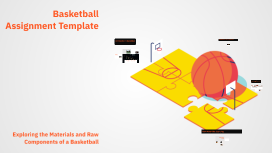Basketball Assignment Template
Transcript: Basketball Assignment Template Main Materials Used in Basketball Introduction to Basketball Inflation Bladder The inflation bladder of a basketball holds air and maintains optimal pressure for bounce and playability. Made from materials like rubber or latex, the bladder is crucial for performance, ensuring the ball retains its shape and responsiveness during games. Rubber Rubber is typically used in outdoor basketballs due to its durability and resistance to weather. It provides a decent grip and bounce, making it suitable for rough playing conditions, although it may lack the premium feel of leather or composite options. Main Materials Used in Basketball Basketballs are primarily made from four main materials, each contributing uniquely to performance, durability, and gameplay experience. Understanding these materials provides insight into the quality and characteristics of the basketball used in sports. Leather Composite Materials Leather is traditionally used in high-quality basketballs, providing superior grip and control. Its natural properties absorb moisture, enhancing ball handling under various playing conditions and ensuring durability and longer life span compared to synthetic materials. Composite materials blend synthetic components designed to mimic the performance of leather while being more cost-effective. They offer excellent grip and durability, suitable for both indoor and outdoor play, making them a popular choice among players. Importance of Materials Overview of Assignment Goals The materials used in basketball significantly affect performance, durability, and player safety. High-quality materials ensure the balls maintain their shape, handling, and bounce, influencing the overall quality of the game. This assignment aims to explore the main materials and raw components of basketball, highlighting their properties and sourcing. By examining these, participants will gain insights into how materials impact the game and sustainability efforts. History of Basketball Basketball was invented in 1891 by Dr. James Naismith in Springfield, Massachusetts, as a response to the need for a new indoor sport. Over the decades, it evolved from a simple game played with a soccer ball to the multi-billion dollar industry it is today, influenced by innovations in materials and design. Introduction to Basketball Basketball, a globally popular sport, has a rich history intertwined with its materials. Understanding the evolution of basketball and its components is essential for appreciating the game. Environmental Impact and Sustainability Environmental Effects of Raw Material Extraction The extraction of materials for basketballs can lead to deforestation, habitat loss, and pollution. For instance, rubber tapping in tropical forests affects biodiversity and contributes to climate change. Sustainable Practices in Material Sourcing Environmental Impact and Sustainability Incorporating recycled materials and organic sources is key to sustainable basketball production. Companies are increasingly using synthetic leathers made from recycled plastics, reducing waste and resource consumption. The sustainability of basketball production is critical for minimizing environmental damage. This section examines the impact of raw material extraction and highlights practices to promote eco-friendly manufacturing. Conclusion and Recommendations Future of Eco-Friendly Basketballs Advancing sustainability in basketball production requires a commitment to responsible sourcing and innovative materials. Manufacturers should prioritize eco-friendly practices to mitigate environmental impact. The future of basketballs looks towards eco-friendly alternatives, such as plant-based materials and biodegradable options. Innovators are exploring these avenues to meet growing consumer demand for sustainable products. Raw Materials Sourcing Exploring the Materials and Raw Components of a Basketball Raw Materials Sourcing Global Supply Chain Overview This section examines the vital sources of raw materials used in basketball production, focusing on natural rubber, synthetic materials, and leather. Understanding these components and their supply chains can illuminate sustainability issues within the industry. The global supply chain for basketball materials is complex, involving multiple stages from raw material extraction to final product delivery. Key players include suppliers, manufacturers, and distributors, each facing challenges related to logistics, cost, and sustainability initiatives. Natural Rubber Sources Leather Production Process Natural rubber is primarily sourced from the Hevea brasiliensis tree, mainly found in Southeast Asia, Africa, and South America. The process involves harvesting latex sap, which is then refined into sheets for manufacturing basketballs. Leather used in basketballs is generally cowhide, which undergoes several processing steps: tanning, dyeing, and finishing. The tanning process, essential for

















